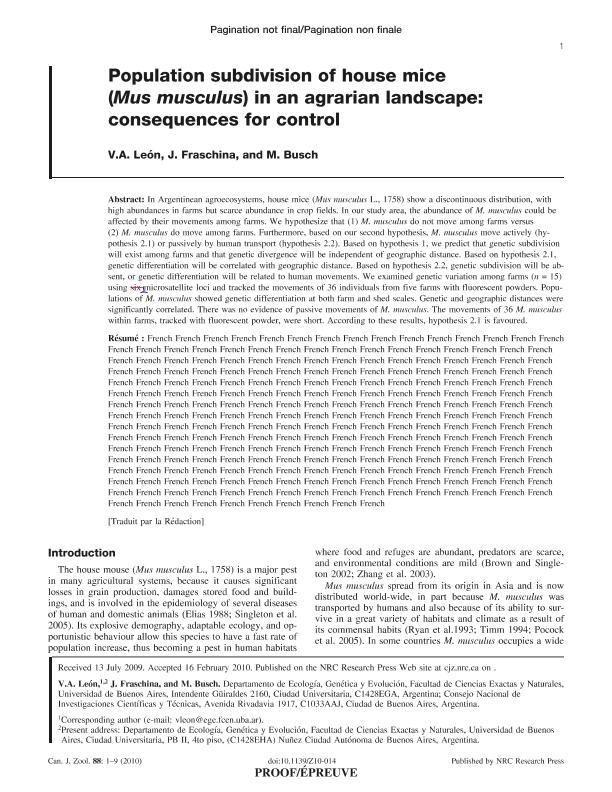Artículo
Population subdivision of house mice (Mus musculus) in an agrarian landscape: Consequences for control
Fecha de publicación:
05/2010
Editorial:
National Research Council Canada-NRC Research Press
Revista:
Canadian Journal of Zoology
ISSN:
0008-4301
Idioma:
Inglés
Tipo de recurso:
Artículo publicado
Clasificación temática:
Resumen
In Argentinean agroecosystems, house mice (Mus musculus L., 1758) show a discontinuous distribution, with high abundances in farms but scarce abundance in crop fields. In our study area, the abundance of M. musculus could be affected by their movements among farms. We hypothesize that (1) M. musculus do not move among farms versus (2) M. musculus do move among farms. Furthermore, based on our second hypothesis, M. musculus move actively (hypothesis 2.1) or passively by human transport (hypothesis 2.2). Based on hypothesis 1, we predict that genetic subdivision will exist among farms and that genetic divergence will be independent of geographic distance. Based on hypothesis 2.1, genetic differentiation will be correlated with geographic distance. Based on hypothesis 2.2, genetic subdivision will be absent, or genetic differentiation will be related to human movements. We examined genetic variation among farms (n = 15) using five microsatellite loci and tracked the movements of 36 individuals from five farms with fluorescent powders. Populations of M. musculus showed genetic differentiation at both farm and shed scales. Genetic and geographic distances were significantly correlated. There was no evidence of passive movements of M. musculus. The movements of 36 M. musculus within farms, tracked with fluorescent powder, were short. According to these results, hypothesis 2.1 is favoured.
Palabras clave:
Mus Musculus
,
Diferenciación Genética
,
Microsatélites
,
Granjas Avícolas
Archivos asociados
Licencia
Identificadores
Colecciones
Articulos(IEGEBA)
Articulos de INSTITUTO DE ECOLOGIA, GENETICA Y EVOLUCION DE BS. AS
Articulos de INSTITUTO DE ECOLOGIA, GENETICA Y EVOLUCION DE BS. AS
Citación
Leon, Vanina Andrea; Fraschina, Jimena; Busch, Maria; Population subdivision of house mice (Mus musculus) in an agrarian landscape: Consequences for control; National Research Council Canada-NRC Research Press; Canadian Journal of Zoology; 88; 5; 5-2010; 427-435
Compartir
Altmétricas




